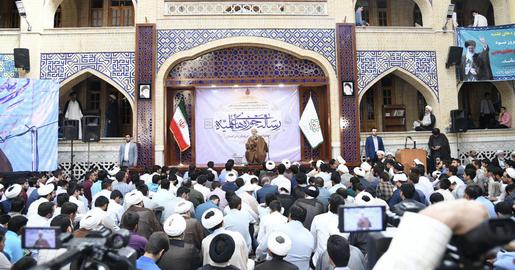When the renowned Iranian-Canadian architect Hossein Amanat accepted an honorary Doctor of Letters at the University of British Columbia last week, in Vancouver, Canada, he said he was indebted to his homeland's "ancient tradition of design and construction, lasting at least three millennia," and that these influences had driven a career spanning some 60 years.
But a moment earlier, and close to tears, Amanat had also been moved to thank his adoptive home for something Iran could never quite guarantee.
"I am thankful for all the opportunities, the safety and freedom, especially freedom," Amanat said, his voice choking for a moment, "that Canada has generously offered to me and my family, free from ethnic or religious discrimination."
He was referring to the fact that he and his family are Baha'is, members of Iran's largest non-Muslim religious minority, which since the 1979 Islamic Revolution has been persecuted in every area of life. Amanat was outside Iran at the time of the Revolution and has never been able to return.
Before he left Iran, however, he had built a celebrated profile as an architect when, aged just 24, he won a national competition to design a monument commissioned by the Shah to mark 2,500 years of Iranian history. The structure that emerged, in 1971, was called the "Shahyad," a tribute by the country to the shahs of Iran. Today the building has come to symbolize Iran both inside and outside the country because of its unique blending of traditional Persian architecture with modern design.
Amanat learned much from the traditional structures and urban design concepts of his native Iran, he said when accepting the degree. "The city square, or maidaan, the bazaar (market), the caravanserai (roadside inn), the mosques and other public buildings, with their distinct arches and domes … I visited many of these structures and was inspired by the beauty and functionality. It became my lifelong quest to discover the mysteries that govern these spaces, that make such an impact on the human soul."
Finding that the design elements and geometry of these ancient structures were often "compatible with modern architecture," Amanat said, led him to study the architectural traditions of other cultures and to learn from their subtleties and achievements.
Bringing these traditions together inspired a design for the Shahyad that was a reference to the cultural history of Iran and symbolized the link between its heritage and modern diversity.
In a conversation with IranWire, after he received the degree, Amanat says that "during 50 years of standing there, [the Shahyad] is more and more in connection with the people of Iran. Its popularity has grown … I have observed it: especially during the Zan, Zendighi, Azadi (Woman, Life, Freedom) uprisings. They used to go there and talk to the people of their country, under that tower."
Before the 1979 revolution, Amanat was also commissioned to design several other major structures in Iran, including a building for Sharif University, one of Iran's leading science and technology institutions, the faculty of business and management at Tehran University, the Persian Heritage Center, and Iran's embassy to China in Beijing.
News of the honorary degree spread around Iran and through the diaspora last week. Iranians inside Iran, in particular, responded to Amanat's use of the word "freedom" during the degree ceremony, he says, and many Iranians left supportive messages across social media.
"Many people wrote, 'We cried, we cried with you,'" he says, and they added that, just as he had choked on "freedom" in his remarks, the same word has been caught in their own throats for 45 years.
Such sentiments take on even more weight because of Iran's recent Woman, Life, Freedom movement, with its mass protests, and after the appalling spectacle of violent crackdowns, executions, incarcerations, and the persecution of minorities, which bulldozes every day over the land.
Amanat was forced to rebuild his career outside Iran, after 1979, and he resettled in Canada where he still maintains an active architectural practice. He has designed cultural and commercial buildings for commissions around the world, in particular across North America and China, and even a Baha'i house of worship on the South Pacific island of Samoa. He also designed the offices of the Baha'i World Centre in Haifa, Israel, drawing from classical Greek architecture.
And a new Baha'i shrine in Israel – now under construction – is a return to a modern form with echoes of the same ideas that informed his design of the Shahyad.
But: Hossein Amanat calls his masterwork the "Shahyad" even though its name has been changed in his country of birth. When the Shah was overthrown and the Islamic Republic came to power, in 1979, the structure was renamed the "Azadi" Tower, or Freedom Tower, heralding the cruel irony and double standards that have characterized life in Iran since the Islamic Revolution.
For Amanat – who choked on the word "freedom" at the University of British Columbia, yet who betrays no hint of resentment after so many decades in exile, and instead only a love for his home – perhaps his creation can never be called "Azadi" until the promise of such a name comes true.
"The Shahyad monument is an example of references to the history and culture of [Iran]," he said, during the degree ceremony. "Shahyad's message is one of belonging and continuity, belonging to a modern and inclusive society, and continuity of a complex and diverse history. … It is for this reason that, half a century after its completion, it has continued to be a physical symbol of today's Iranian identity."




























comments